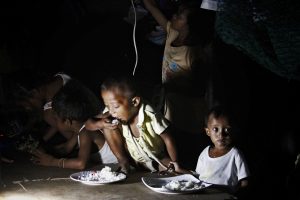A TALE OF TWO GIVERS

Tanga ka ba o Dakila?
May 8, 2021
Not Now, Not Yet Lord.
May 12, 2021This is a tale of two givers – HAVE-NOT and HAVE.
HAVE-NOT lives in dire poverty. She was a teen when she got pregnant, sired six children with a husband who worked as a construction worker. He died early and Have-Not was left to fend for herself and her brood of six. She sold turon as an ambulant vendor. On weekends, she worked as laundrywoman for dorm residents near her shanty. Through hard work and persistence, she was able to send her children to public school but like her, they were not able to finish college. Two died before they reached the age of puberty. Like her, the rest married early. HAVE-NOT had to slow down and stop selling turon to look after her grandchildren. They are one big struggling but happy family in a shanty occupied by four households.
When the pandemic broke out in 2020, HAVE-NOT’s sons and daughters-in-law lost their jobs one after another. Food was hard to come by. In the second year of the pandemic, their economic condition slid further. Her grandchildren had dropped out of school because there was no money to buy gadgets for online education. HAVE-NOT discovered the existence of a community pantry one day as she was selling turon. An unmanned rattan cart full of vegetables, bread and other food items caught her attention. A hand-written signage bore the words: “Kumuha ayon sa pangangailangan, magbigay batay sa kakayahan.” The offer was tempting. She looked around and found no one manning the cart. She surveyed the items before her. She made a quick mental calculation. A loaf of bread, three eggs, a bunch of kamote tops and a pack of rice would be enough to feed her brood. She could use her meager profit from selling turon to buy half a kilo of fish. Still looking sideways to check if somebody was watching, she took the items she needed and put them in her basket. She had nothing to give in exchange for the items except turon. She wrapped six pieces of these in a brown bag then left them on top of the cart. She silently thanked whoever it was who set up that cart. As soon as she arrived home, she excitedly told her neighbors about the free food items and told them the cart’s location. She returned the next day. This time, she left a dozen turons as her contribution.
HAVE, on the other hand, lives a life of plenty. He is influential and successful. Many people owe him money. Anybody who comes to him does not go home empty-handed. He always has available cash to lend. One day, one of his borrowers came to see him to ask for extension of deadline for payment. He checked the debtor’s statement of account and shook his head. “That isn’t possible. You’ve defaulted on payment several times.” “But I have nothing to give you at this point, Sir,” the debtor begged. “I heard that you have a lovely daughter. I’ll take her as collateral. You’ll get her back once your loan has been fully paid,” said HAVE firmly. Debtor was speechless. She loves her daughter and the reason why she borrowed money was to pay for her daughter’s college education. Seeing the debtor’s hesitance, HAVE made a litany of the favors he had extended to debtor’s family. Debtor was crestfallen. She asked for time to consult her family about the “payment” that HAVE was exacting for her loan. She was surprised when she heard her husband’s words: “By all means, give in to his wishes. We owe him a debt of gratitude. He is our friend.” Sounds familiar?
Recently, I chanced upon a community pantry social experiment by a vlogger who goes by the moniker Foreign Germs. He set up several pantries in various parts of Metro Manila. The experimental pantries had signages saying, “Smile before getting”; “Kapag napapaligaya kita, lumiligaya rin ako”; “Tumulong tayo sa iba kahit pa tayo ay hirap ding tulad nila”; and “Huwag magpadala sa emosyon”; “Baka lumagpas ka sa limitasyon.” Everything was captured on video.
Video Credit: Pulubing Foreigner Pakyaw Paninda Foreigngerms FB Page
Initial reaction of passersby was one of curiosity. They stared, slowed down to read the note, then went on their way. In one pantry, some of the food items were scattered on the ground; it must have been intentional. Two female passersby immediately stopped to pick up the items and arrange these on the table. An old man lingered near one pantry, wondered why no one was manning it, then hesitantly picked some items. He then called a tricycle driver to share the news. “It is free!” he said.

Art work (from FB): Chico David
By word of mouth, the news spread and people began flocking to the pantries. They were not unruly. They waited for their turn and admonished each other to take only one (isa-isa lang) loaf each and leave some for the others. The video captured some of the recipients taking extra items not for themselves but for others who could not get near the pantry. They took loaves of bread and threw these over the bakod (fence) for the construction workers who were watching nearby. They passed on the eggs by inserting their hands under the bakod to waiting hands at the other side. The takers became givers as they found means to share the goods with others. This five-minute video affirmed what we, who have had exposure to social action, have known all along – that given the chance, takers would want to be givers, too. It is no wonder why Filipinos have this beautiful saying, “Isusubo na lang, ibibigay pa sa iba.” (meaning what s/he is about to eat, s/he gives away without hesitation). It speaks of utmost generosity.
Picture a malnourished child who is part of a feeding program as participant. S/he sets aside a portion of her/his ration so that her/his younger siblings at home could partake of the nutritious food, too. I met a nun who used to supervise a church-based feeding program. She recalled that some of her wards did not gain weight because these children opted to share the food with their younger siblings. One time, she caught one of them handing a portion of his meal to somebody under the table. The nun looked under the table and found the boy’s younger sibling hiding there, waiting for kuya’s ration. Others brought plastic bags to wrap half of their meal to serve as pasalubong to their younger siblings.

Photo Credit: Vincent Go
Generosity is evident in community rituals, too. When I did some studies on rituals attached to Catholic devotions in the province of Pampanga, I noted that most of these involve the element of giving/sharing. Before Mt. Pinatubo erupted, when waterways were not silted and clogged, fluvial processions were held in honor of Apung Iru (St. Peter) in Apalit, Apung Lucia (St. Lucy) in Sasmuan, and Apung Tiago (St. James) in Betis. The townsfolk would throw food items to each other as a way of sharing their blessings and as a way of feeding each other during the long hours of the fluvial procession.
The history of Kapampangans’ devotion to Virgen de los Remedios (Our Lady of Remedies, Patroness of Pampanga) is a beautiful story of awakening to the value of giving. It began in 1952 at the height of social unrest in the province. Bp. Cesar Ma. Guerrero uttered his now-famous remark,”Aqui en la Pampanga hay mucho piedad pero poca caridad” (Here in Pampanga, there is much piety but little charity.) after the newly-installed Bishop visited the parishes in his care and noted the disparity in the quality of life and the ensuing tension between the rich and the poor. He initiated the Crusade of Charity and Goodwill (which later became Crusade of Penance and Charity) and introduced the concept of a gift-giving ritual called lamac (meaning offering) to emphasize the value of sharing in healing the wounds of social division. It works this way: As the images of Virgen delos Remedios and Sto. Cristo del Perdon make the rounds of parishes all year round, every parish they visit prepares gifts and donations to be given to the poor in the next parish to be visited. In effect, it is a chain of love and generosity that has remained unbroken to this day, seventy years after it began.
https://pintakasi1521.blogspot.com/2018/01/virgen-de-los-remedios-de-pampanga.html
This type of giving is fueled by love, compassion, and empathy. Compare this with toxic giving– the type that waits for an ROI (return on investment). The giver expects to get something in return. Gift becomes capital intended to earn profit: one for you, two for me. This kind of giving is fueled by greed. It is the type that is devoid of virtues.
GIFTED TO GIVE
I wonder how we would have celebrated the 500th anniversary of Christianity if this pandemic did not happen. There would have been historical conferences, a coffee-table book, and other events to mark this milestone for sure. Our own group, The Storytellers’ Society, Inc. was preparing for the implementation of quite ambitious projects at the start of 2020. We planned on creating an app that would serve as repository of Catholic resources in the Philippines. We also planned on filming a pilgrimage to the Holy Land with bible scholar Bp. Ambo David as narrator. We also wanted to introduce the Visita Ecclesia, a visit not to seven heritage churches but to seven living churches of the poor. Alas, God had other plans for humanity.
500 years after missionaries came to sow the seeds of Christianity in our land, the story of the multiplication of loaves and fishes is happening before our eyes, with us as participants instead of onlookers My cousin, who helps run a community pantry in Eastwood was emotional when she related her experiences. “It melts the heart. People plead with us to continue this project. They contribute whatever they can to keep it going. Some give twenty pesos; some give two hundred pesos.” The community pantry project empowers the taker to be a giver, too. It is not only about feeding the body; it is also about feeding the soul.

Photo Credit: Community Pantry PH FB Page
This pandemic has taught us that the best way of celebrating faith is by putting it into action – not merely paying lip service but by taking concrete action to ease the sufferings of the marginalized and neglected in society. It has separated us physically, but it has united us in spirit. We have learned to fill each other’s cup.




